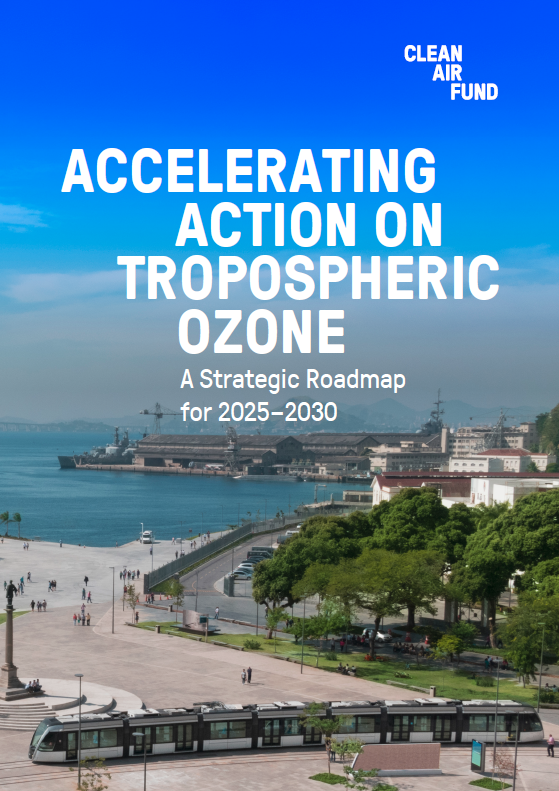
Tropospheric ozone is a powerful but under-addressed greenhouse gas and super pollutant that poses a triple threat to climate stability, public health, and food and ecosystem security. Action to reduce tropospheric ozone is uniquely positioned to help achieve climate and health goals if we strategically utilise the policies, platforms and frameworks already in place.
The impacts of tropospheric ozone:
0.23ºC global warming to date
500,000 premature deaths per year
What is tropospheric ozone?
Ozone exists in two layers of the atmosphere: the troposphere and the stratosphere. Tropospheric ozone is ‘bad ozone’ closer towards earth’s surface, which is different from the ‘good ozone’ layer in the stratosphere, which protects us from harmful radiation.
Unlike many other pollutants and gases, tropospheric ozone is not emitted directly, but is formed through complex chemical reactions involving methane, nitrogen oxides (NOx), carbon monoxide (CO), and non-methane volatile organic compounds (NMVOCs) in the presence of sunlight. Many of these ‘precursors’ are co-emitted from key sectors such as transport, energy, waste and industry. The relationship between ozone and its precursors is nonlinear, so reducing just one precursor in isolation may not reduce ozone – and could even increase it under certain atmospheric conditions.
These interactions make ozone a uniquely challenging pollutant to manage, but it cannot be ignored. As the world rapidly warms, levels of tropospheric ozone are projected to increase in all business-as-usual scenarios, exacerbating the most damaging impacts of climate change and harming health, agriculture and ecosystems.
An integrated approach to a triple threat
Responsibility for reducing ozone typically falls to sub-national actors (i.e. cities and states) trying to achieve national air quality standards. Yet, this only tackles part of the ozone problem. Methane mitigation addresses some of the climate impacts of ozone as an unintended and indirect byproduct. The agricultural and ecosystem effects of ozone are almost not addressed at all. This fragmented approach cannot prevent ozone’s projected increase, undermining global climate and health agendas.
Tropospheric ozone is complex, but the technical complexities cannot deter us from urgent and strategic action. Ozone is a systems problem, and we must treat it with a systems solution. This roadmap calls for an integrated approach based on three principles:
- Multi-pollutant strategies: These consider tackling multiple pollutants together – rather than one by one – to avoid unintended consequences, maximise co-benefits and ensure ozone reduction efforts are effective given its complex chemistry.
- Multi-level governance: Coordinated action across global to local institutions ensures ozone is addressed consistently within climate, air quality and health policies, avoiding disjointed or conflicting responses.
- Cross-sectoral collaboration: Addressing ozone requires solutions across diverse sectors – from transport to wildfires – and requires aligning existing policies and integrating ozone where it’s been overlooked.
A strategy to 2030
Ozone is not just a scientific puzzle, but a real-world pollutant rising in many regions, even where other pollution is falling. The next five years are a decisive window for climate and sustainable development. To limit global warming to 1.5°C, as outlined in the Paris Agreement, global greenhouse gas emissions must be reduced by 45% from 2010 levels by 2030 and reach net zero by 2050.
At the same time, we must reduce super pollutants like methane, tropospheric ozone and black carbon to secure fast climate benefits and avoid crossing critical tipping points.
This roadmap outlines a strategy to 2030 that builds on existing climate and air quality platforms while embedding ozone into broader systems of governance. Previously, we made The Case for Action on Tropospheric Ozone, based on the promise of fast, cross-cutting environmental and health gains. This roadmap focuses on how to put those recommendations into motion by integrating ozone action into existing opportunities, strategies and systems. This could transform what is currently fragmented and invisible into powerful joined-up action.
This roadmap is structured around four pillars:
- Scientific evidence into policymaking: Closing gaps in data, modelling, and understanding of ozone’s impacts across spatial and temporal scales.
- Integrated policy and governance: Embedding ozone within global frameworks, regional agreements and national climate and air quality plans.
- Accelerating targeted measures: Scaling up practical, multi-sectoral solutions within and outside of existing decarbonisation efforts.
- Increased awareness through communications: Elevating ozone in political discourse and supporting shared understanding of its impacts and solutions.
Together, these workstreams provide a coordinated, actionable plan to reduce tropospheric ozone, protect public health, safeguard food and ecosystems, and help deliver meaningful climate mitigation by 2030. Read the report for our full recommendations.


